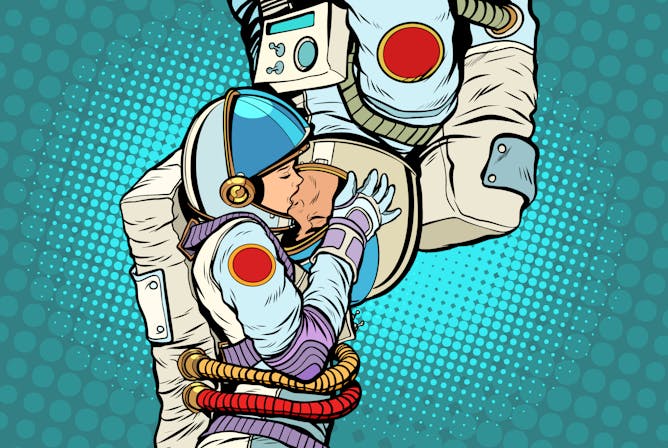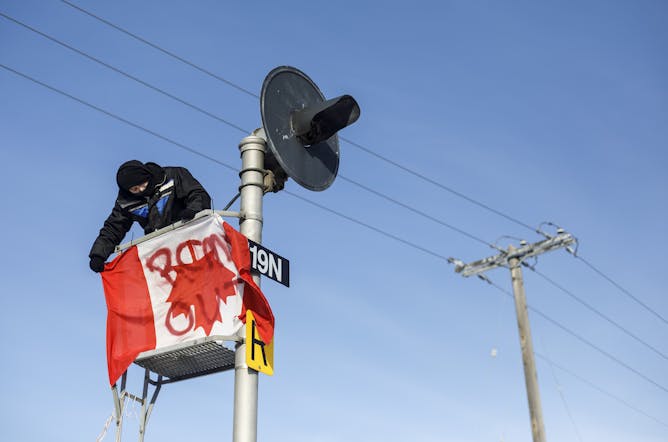|
Philip K. Dick’s 1968 science fiction novel Do Androids Dream of Electric Sheep? (the source material for the Blade Runner movies) is a commentary on human-robot relations where the robots are designed as replacements for living creatures—in one storyline an android falls in love with and seduces the protagonist.
On February 6, 2020, astronaut Christina Koch returned from a 328-day-long mission; this was the longest a female astronaut had ever spent in space. Her record-setting mission will reveal information about what happens to the human body in space.
Public and private institutions like SpaceX and NASA are announcing plans for several future missions to the moon and Mars, and lengthy spaceflights will soon become more common. But what about sex and the desire for intimacy in space?
Today in The Conversation Canada, researchers Simon Dubé and Dave Anctil suggest that maybe sex technologies like erobots, remotely controlled sex toys and virtual reality could be a practical solution. But first, we’ll need to shed our taboos and recognize the role that intimacy and sexuality play in our well-being.
Also today:
|

As plans for space exploration expand, how will sex and desire be addressed in these larger, longer missions?
(Shutterstock)
Simon Dubé, Concordia University; Dave Anctil, Université Laval
Sex technologies and 'erobots' could help address issues related to human desire, and physical and emotional needs of astronauts in space.
|

Supporters of the Wet'suwet'en block a CN Rail line just west of Edmonton on Feb. 19, 2020.
THE CANADIAN PRESS/Jason Franson
D.T. Cochrane, York University, Canada
Governments and corporations seem to understand that the landscape of Indigenous resistance has shifted.
|

Dolly Parton is having a pop culture moment. The ‘Dolly Parton’s America’ podcast explores belonging and ‘home.’ Here she performs with Joel Smallbone, left, and Luke Smallbone, right at the 53rd Annual CMA Awards in Nashville, Tenn.
AP Photo/Mark J. Terrill
Travis Salway, Simon Fraser University
Why does Dolly Parton have such broad appeal, across lines of race, nationality, gender identity and sexual orientation?
|

Grâce aux techniques d'hypertrucage, Loto-Québec a réussi à transformer un comédien en Bernard Derome des années 70 pour une publicité.
Loto-Québec
Nadia Naffi, Université Laval
La capacité de détecter et d'analyser des vidéos truquées est de la plus haute urgence. Les contrefaçons constituent une grave menace pour la sécurité des personnes et nos institutions démocratiques.
|

Consommer trop de protéines animales accroit les risques de développer un large éventail de maladies chroniques en raison des acides aminés contenus dans la viande, révèle une étude.
Shutterstock
Laura Brown, Teesside University; Kelly Rose, Teesside University
Consommer trop de protéines animales accroit les risques de développer un large éventail de maladies chroniques en raison des acides aminés contenus dans la viande, révèle une étude.
|
Culture + Society
|
-
Anne P. DePrince, University of Denver; Jennifer M. Gómez, Wayne State University
Studies show the physical and emotional pain of minorities and women is often discounted by both the U.S. justice and health care systems. That has serious consequences.
|
|
Health + Medicine
|
-
Wanda Markotter, University of Pretoria
Understanding the many factors that may play a role in spillover of pathogens from bats to humans requires systematic surveillance of bat populations.
|
|
Politics
|
-
Rowan Callick, Griffith University
China's leader is facing one of the greatest challenges of his presidency. But the extent of China’s controls almost rule out monumental change – or Xi taking accountability for his mistakes.
|
|